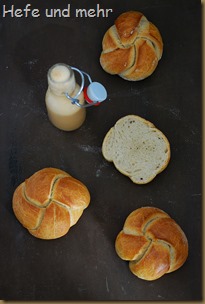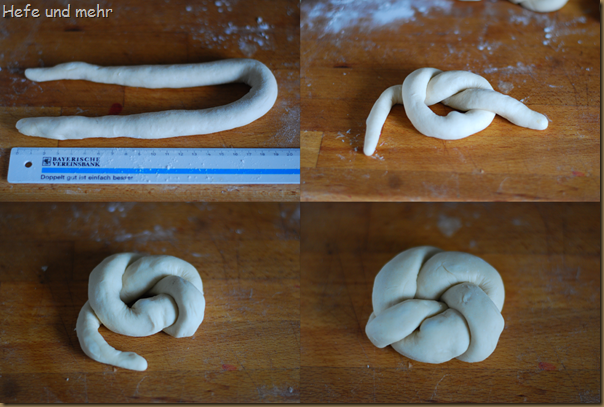
Until the 18th century bakers went to the next brewery to get some yeast for baking. Even the name of the yeast we use for baking shows that it was originally used for making beer: Saccharomyces cervicae. But when the new bottom fermenting yeast strain Saccharomyces carlsbergensis used by more and more breweries getting yeast for baking was not possible anymore because this yeast stays on the bottom of fermenting vessel (instead on floating on top like S. cervicae.) And so the first commercial produced yeast for bakers appeared on the market in 1780.
When my love and me brew beer it always breaks my heart to throw away the yeast which remains after bottling. And because I search ancient recipes for this month BBD, I decided to bake rolls using the beer yeast instead of the “normal” bakers yeast (which is the same species, anyway).
Because I could not estimate how active the yeast was I decided to prepare a preferment first and to let it rise in the fridge for 24 hours. During this time span the dough nearly tripled and so I mixed the dough the next night and let it ferment at room temperature until the next morning. Putting the rolls in the oven was then the most exiting part and I spent the first 10 min of the baking progress sitting in front of the oven and observing the great ovenspring.
And when I pull the rolls from the oven I was very happy with the result. They have soft crumb and crisp crust and their taste is niecly complex due to the long fermentation. The old method is still working greatly 🙂
Knots (baked with brewers yeast)
yields 10 rolls
Preferment
- 100g flour Typ 550
- 100g Water
- 10g sedimented brewers yeast, left in the fermenting vessel after bottling (or 3g fresh yeast)
Dough
- preferment
- 400g flour Type 550
- 15g Malt
- 20g soft Butter
- 10g Salt
- 200g Water
For the preferment mix all ingredients and let it rise for 24 hours in the fridge.
The next evening knead all ingredients for the dough by hand for 8-10 min.
Ferment overnight at roomtemperature (about 10 –12 hours).
The next morning preheat the bread baking stone in the oven to 250°C.
In the meantime divide the dough into pieces of 80g each. Roll each piece to a strand with a length of 30 cm Make a knot of the strand, then put on free end in the middle and tuck the other under the roll.
Proof for 40 min.
Bake for about 20 min at 250°C with steam.
I sent this entry to Yeastspotting, Susans weekly showcase of yeast baked good.
Deutsch



Also die Bierhefe könnt Ihr von mir bekommen. PLZ 90xxx
@Bierhefe: Das ist ein nettes Angebot.
Ich habe ein paar französische Rezepte, die Bierhefe angeben. Jetzt weiß ich endlich was damit gemeint ist 🙂
Vielen Dank für die Anregung zum Selberbrauen…
Ne also das Bierbrauen fang ich jetzt nicht auch noch an 😉 zuviel andere offene Projekte hier *lach * Hmmm einen Bierbrauer im nahen Umfeld kenn ich leider auch nicht, insofern Trockenbierhefe! Wie wird die dann dosiert? Und ich sehe gerade, dass im Hauptteig keine zusätzliche Hefe zugesetzt wird, ist das richtig? Herzlichst Nadja
@Naddi: Das dachte ich mir schon fast 🙂 Ich würde 1g Trockenhefe nehmen, das müsste ganz gut hinkommen. Und dem Hauptteig habe ich tatsächlich keine weitere Hefe zugesetzt, durch die lange, warme Stockgare braucht es nicht mehr.
Stefanie das sind wunderschöne Brötchen geworden 🙂 Aber irgendwie schon gemein, wie komm ich denn jetzt an Bierhefe 😉 Man darf mir doch solche abgefahrenen Sachen nicht präsentieren, dann will ich sie doch auch haben *lach* Schönes Wochenende. Herzlichst Nadja
@Naddi: Aaaalsooo, das geht so: Du kaufst dir Malz, Hopfen, Hefe und einen Gärbehälter und sagst dem Zollamt Bescheid, dass du Bier brauen möchtest. Dann braust du ein schönes Bier und bekommst (neben dem Bier) auch noch Treber und Bierhefe zum Spielen 😛 😉
Nein, im Ernst, du könntest auch nur die Trockenbierhefe kaufen und diese direkt verwenden. Oder du hörst dich mal um, ob nicht im Bekanntenkreis jemand jemanden kennt, der Bier braut, der würde dich bestimmt auch mit etwas Hefe-Bodensatz versorgen, davon fällt ja mehr als genug an.